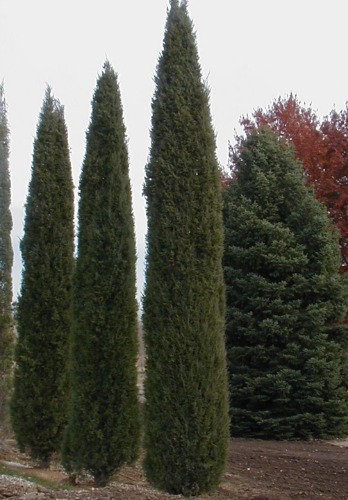Eastern red cedar is a tree that most people consider to be a "weed" in their landscapes, especially in a pasture. It may grow readily in pastures, but it is a great tree for our acreage landscapes, especially as a windbreak. They are native trees and therefore are quite resilient when it comes to insect and disease damage.
There is a great variety of eastern red cedars for other options in your landscape, one that I particularly like, is 'Taylor' juniper.
Taylor juniper, Juniperus virginiana 'Taylor', is a tall, narrow variety of eastern red cedar. It grows up to 15-20 feet tall and only 5 feet wide. It has silvery-blue green evergreen foliage that grows scale-like, just like the red cedar trees. The female trees have blue-purple berries that the birds enjoy. The bark exfoliates off of the trunk. This plant was discovered in Taylor, Nebraska, so it will grow very well in our environment.
Growing
Taylor juniper grows well in most environmental conditions, but takes full sun. It will tolerate deer, drought, erosion, and black walnut trees. This makes it a very desirable tree for many acreages. Because it grows so upright and compact, it is great as an accent tree or for use in a narrow location along a building. Taylor juniper does not tolerate shade or wet soils, so be sure to plant it in full sun where the soils are well drained and water does not sit. Often, Taylor Juniper does lean over in heavy snows but it will pop back up to its original shape when the snow melts.
 'Taylor' is a cultivated variety of eastern red cedar, Juniperus virginiana. Eastern red cedars get this name because in winter their foliage normally turns a maroon-brown color. Don't let the color fool you into thinking there's something wrong with your tree.
'Taylor' is a cultivated variety of eastern red cedar, Juniperus virginiana. Eastern red cedars get this name because in winter their foliage normally turns a maroon-brown color. Don't let the color fool you into thinking there's something wrong with your tree.
Potential Pest Problems
Taylor juniper is fairly tolerant of most insect and disease species, but it is susceptible to bagworms, like most other cedar tree species. They can also be damaged by spider mites. If you have susceptible apple trees, do not plant this tree in the vicinity, as Taylor juniper is susceptible to cedar-apple rust, just like eastern red cedar. In cedar trees, however, cedar-apple rust rarely causes damage. Cedar-apple rust shows up on cedar trees as a hard brown gall early in the spring and with the spring rains becomes an orange finger-like gall. The damage appears on apple trees or hawthorn trees.
Uses
The straight species of eastern red cedar has been used for many different wood products, that Taylor juniper could be used for as well, including fence posts, cedar chests, pencils, and medicines, according to North Dakota State University. They are also a great benefit to the wildlife found on your acreage as the birds enjoy eating the berries and many wildlife use these dense trees as a habitat.
Taylor juniper is a great choice for any landscape. It is very columnar so it can fit into many locations in your landscape. It can be placed as a specimen tree or many can be planted together to form a fence. It is a great tree for wildlife and for aesthetic appeal to your landscape, on an acreage or in town.
So the next time you are looking for a narrow and tall tree for year-round interest, choose Taylor juniper, a tree that was discovered in Nebraska.

